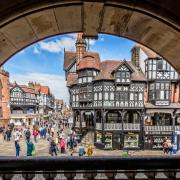North Wales is a hotbed of history with its medieval towns, important sites and ancient fortifications.
In ancient times the region was subject to skirmishes between the English and Welsh as they fought for control of the border, culminating in Edward I (1239 to 1307) imposing English rule here over the native population. As part of his campaign, Edward ordered castles and military fortifications to be built in North Wales to achieve his goal of bringing the area under direct English control. To this purpose, the monarch decreed that a castle be built in the town of Conwy. The magnificent landmark was constructed over four years between 1283 to 1287, becoming a significant fortification in the area and a vital asset in Edward’s campaign to dominate and intimidate the enemy and enforce English rule across Wales.

Conwy Castle was designed by James of Saint George, an architect responsible for many significant fortifications in the 13th century. The castle was to play a major part in English history throughout the centuries. Between December 1294 and January 1295, Edward himself was besieged at Conwy by the Welsh. The only way the castle could be supplied with essential goods was by sea, until in February, more English forces arrived to relieve the site. The castle became the main residence for many important figures including Edward’s son who stayed at Conwy in 1301. He would become King Edward II and carry on his father's work.
By the end of the 14th century, Conwy Castle gave refuge to Richard II who was being pursued by the forces of Henry IV, also known as Henry Bolingbroke. Henry took the throne in 1400, sparking a rebellion in North Wales under the command of Owain Glyndŵr, the last true Welshman to hold the title of Prince of Wales.
Glyndŵr, his brother and cousins attacked the castle in March 1401, holding it for three months before surrendering on condition that they were given a royal pardon by English king.

By the 17th century, the castle had fallen into a state of disrepair. King Charles I decided he had no further use for it and in 1627 he sold the site to Edward Conway for the sum of £100. When civil war broke out in 1642 the castle was taken over by John Williams, Archbishop of York, on behalf of the king. In 1646, Cromwell’s army besieged the castle remaining there for three months. The monarchy was finally restored and ownership transferred to the Earl of Conwy who was to strip the castle of its lead, iron and timbers, leaving the structure to the elements.
By the 19th century, roads had been constructed across the river Conwy providing a vital new link between the town and Llandudno. Today the castle is classed as a scheduled monument (a nationally important UK archaeological site or historic building, given protection against unauthorised change) and is open to visitors, under the control of Cadw.
As well as its castle, Conwy boasts complete medieval castle walls, stretching for three-quarters of a mile surrounding the whole of the town. They include 21 towers and three of the original gateways.
As you walk the walls you often find yourself level with the rooftops of houses, looking down onto the medieval streets of the town below, and across to Snowdonia in the distance.
You can view many of my local history films featuring historical locations around Cheshire and beyond by visiting my history channel, youtube.com/@Tvpresenter4history.

Things to do
Walk the impressive castle walls with 21 towers
Visit the castle ruins and medieval exhibits
See the 19th-century gothic-style Telford suspension bridge
Look inside the smallest house in Britain



























